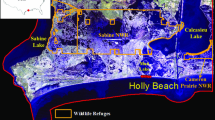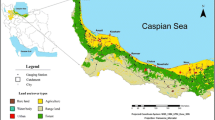Abstract
This paper examines whether multiple regression analysis and neural network models can be applied successfully for the indirect prediction of the runoff treatment performance with water quality indicator variables in an experimental storm water detention system rig. Five biologically mature experimental storm water detention systems with different designs treating concentrated gully pot liquor (spiked with dog droppings) were assessed. The systems were located on The King’s Buildings campus at The University of Edinburgh and were monitored for a period of 18 months. Multiple regression analyses indicated a relatively successful prediction of the biochemical oxygen demand and total suspended solids for most systems, but due to a relatively weak correlation between the predictors and both microbial indicators, multiple regression analyses were not applied for the prediction of intestinal enterococci and total coliform colony-forming units. However, artificial neural network models predicted microbial counts relatively well for most detention systems.






Similar content being viewed by others
References
Brion, G. M., & Lingireddy, S. (2003). Artificial neural network modeling: a summary of successful applications relative to microbial water quality. Water Science and Technology, 47, 235–240.
Bulc, T., & Slak, A. S. (2003). Performance of constructed wetland for highway runoff treatment. Water Science and Technology, 48, 315–322.
Butler, D., & Parkinson, J. (1997). Towards sustainable urban drainage. Water Science and Technology, 35, 53–63. doi:10.1016/S0273-1223(97)00184-4.
Butler, D., Friedler, E., & Gatt, K. (1995). Characterising the quantity and quality of domestic wastewater inflows. Water Science and Technology, 31, 13–24. doi:10.1016/0273-1223(95)00318-H.
EEC. (1991). EEC Urban Waste Water Treatment, Directive 91/271/EEC 1991. Brussels: European Economic Community.
Ellis, B. (1991). Urban runoff quality in the UK – problems, prospects and procedures. Applied Geography (Sevenoaks, England), 11, 187–200. doi:10.1016/0143-6228(91)90029-9.
Gervin, L., & Brix, H. (2001). Removal of nutrients from combined sewer overflows and lake water in a vertical-flow constructed wetland system. Water Science and Technology, 44, 171–176.
Hamed, M. M., Khalafallah, M. G., & Hassanian, E. H. (2004). Prediction of wastewater treatment plant performance using artificial neural networks. Environmental Modelling & Software, 19, 919–928. doi:10.1016/j.envsoft.2003.10.005.
He, L. M., & He, Z. L. (2008). Water quality prediction of marine recreational beaches receiving watershed baseflow and stormwater runoff in southern California, USA. Water Research, 42, 2563–2573. doi:10.1016/j.watres.2008.01.002.
Iyengar, S. S., & Kashyap, R. L. (1989). Autonomous intelligent machines. Computer, 22(6), 14–15.
Jeng, H. C., England, A. J., & Bradford, H. B. (2005). Indicator organisms associated with storm water suspended particles and estuarine sediment. Journal Environmental Science and Health, 40, 779–791. doi:10.1081/ESE-200048264.
Kay, D., Wyer, M., Crowther, J., Stapleton, C., Bradford, M., McDonald, A., et al. (2005). Predicting fecal indicator fluxes using digital land use data in the UK's sentinel Water Framework Directive catchment: The Ribble study. Water Research, 39, 3967–3981. doi:10.1016/j.watres.2005.07.006.
Lee, B. H., & Scholz, M. (2006). A comparative study: prediction of constructed treatment wetland performance with K-nearest neighbours and neural networks. Water, Air, and Soil Pollution, 174, 279–301. doi:10.1007/s11270-006-9113-2.
Maier, H. R., & Dandy, G. C. (1996). The use of artificial neural networks for the prediction of water quality parameters. Water Resources Research, 32, 1013–1022.
Maier, H. R., & Dandy, G. C. (1998). The effect of internal parameters and geometry on the performance of back propagation neural networks: an empirical study. Environmental Modelling & Software, 13, 193–209. doi:10.1016/S1364-8152(98)00020-6.
Maier, H. R., & Dandy, G. C. (2000). Neural networks for the prediction and forecasting of water resources variables: a review of modeling issues and applications. Environmental Modelling & Software, 15, 101–124. doi:10.1016/S1364-8152(99)00007-9.
Mas, D. M. L., & Ahlfeld, D. P. (2007). Comparing artificial neural networks and regression models for predicting fecal coliform concentrations. Hydrological Sciences Journal, 52, 713–731. doi:10.1623/hysj.52.4.713.
McCorquodale, J. A., Georgiou, I., Carnelos, S., & Englande, A. J. (2004). Modeling coliforms in storm water plumes. Journal of Environmental Engineering and Science, 3, 419–431. doi:10.1139/s03-055.
Memon, F. A., & Butler, D. (2002). Assessment of gully pot management strategies for runoff quality control using a dynamic model. The Science of the Total Environment, 295, 115–129. doi:10.1016/S0048-9697(02)00056-6.
Mohanty, S., Scholz, M., & Slater, M. J. (2002). Neural network simulation of the chemical oxygen demand reduction in a biological activated carbon filter. Journal of the Chartered Institution of Water and Environmental Management, 16, 58–64. doi:10.1111/j.1747-6593.2002.tb00369.x.
Neelakantan, T. R., Brion, G. M., & Lingireddy, S. (2001). Neural network modelling of Cryptosporidium and Giardia concentrations in the Delaware River, USA. Water Science and Technology, 43, 125–132.
NRC. (2004). Indicators for waterborne pathogens. National Research Council of the National Academies (NRC). Washington, DC: The National Academies Press.
O’Keefe, B., D’ Arcy, B. J., Barbarito, B., & Clelland, B. (2005). Urban diffuse sources of fecal indicators. Water Science and Technology, 51, 183–190.
Olding, D. D., Steele, T. S., & Nemeth, J. C. (2004). Operational monitoring of urban stormwater management facilities and receiving subwatersheds in Richmond Hill, Ontario. Water Quality Research Journal of Canada, 39, 392–405.
Rogers, L. L., & Dowla, F. U. (1994). Optimization of groundwater remediation using artificial neural networks with parallel solute transport modeling. Water Resources Research, 30, 457–481. doi:10.1029/93WR01494.
Sandhu, N., & Finch, R. (1996). Emulation of DWRDSM using artificial neural networks and estimation of Sacramento River flow from salinity. In Proceedings of the North American Water and Environment Conference (pp. 4335–4340). New York: ASCE.
Sarle, W. (2002). The Neural Network FAQ. ftp://ftp.sas.com/pub/neural/FAQ4.html. Accessed November 2007.
Scholz, M. (2006). Wetland systems to control urban runoff. Amsterdam: Elsevier.
Tomenko, V., Ahmed, S., & Popov, V. (2007). Modelling constructed wetland treatment system performance. Ecological Modelling, 205, 355–364. doi:10.1016/j.ecolmodel.2007.02.030.
Wu, J. S., & Ahlert, R. C. (1978). Assessment of methods for computing storm runoff loads. Journal of the American Water Resources Association, 14, 429–439. doi:10.1111/j.1752-1688.1978.tb02179.x.
Wu, J., Yu, S. L., & Zou, R. (2006). A water quality based approach for watershed wide BMP strategies. Journal of the American Water Resources Association, 42, 1193–1204.
Zhang, G., Patuwo, B. E., & Hu, M. Y. (1998). Forecasting with artificial neural networks: the state of the art. International Journal of Forecasting, 14, 35–62. doi:10.1016/S0169-2070(97)00044-7.
Zurada, J. M. (1992). Introduction to Artificial Neural Systems. St. Paul: West.
Acknowledgements
The authors would like to thank Alderburgh and Atlantis Water Management for their sponsorship, Dr. Kate Heal for her guidance, and numerous occasional students who helped out with technical work.
Author information
Authors and Affiliations
Corresponding author
Rights and permissions
About this article
Cite this article
Kazemi Yazdi, S., Scholz, M. Assessing Storm Water Detention Systems Treating Road Runoff with an Artificial Neural Network Predicting Fecal Indicator Organisms. Water Air Soil Pollut 206, 35–47 (2010). https://doi.org/10.1007/s11270-009-0084-y
Received:
Accepted:
Published:
Issue Date:
DOI: https://doi.org/10.1007/s11270-009-0084-y




